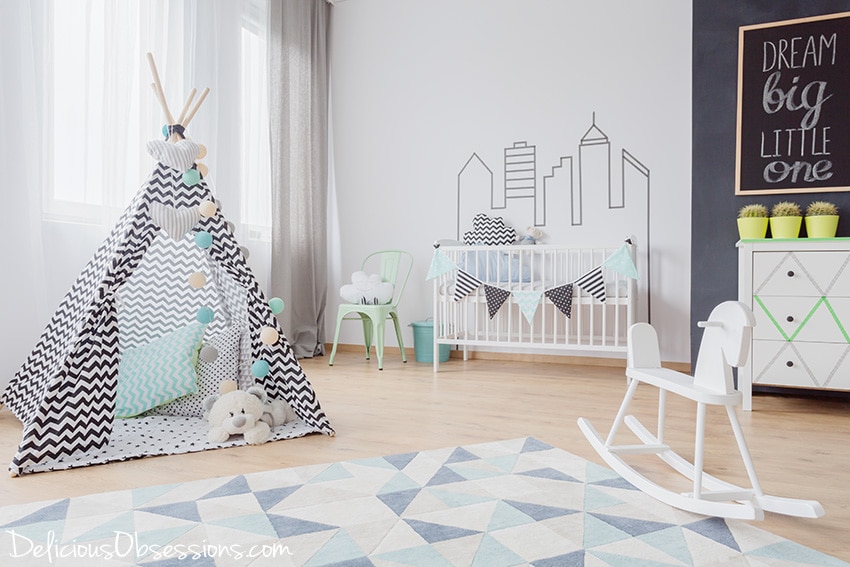FTC Disclosure: Delicious Obsessions may receive comissions from purchases made through links in this article. As an Amazon Associate I earn from qualifying purchases.Read our full terms and conditions here.
If you are expecting a baby (or know someone who is) and are concerned with reducing baby’s chemical exposure, this is the guide for you! In this non-toxic baby products guide, we will be talking about how to choose safer, less toxic items for baby’s nursery and registry.
If you guys have been around this site for any amount of time, you know that I do my best to choose healthier products for myself and my family. I’m far from perfect and I am never 100% non-toxic. But, I strive to do my best within the budget I have, and over the years, I’ve learned A TON about selecting safer, non-toxic products for both personal care (i.e. makeup, skincare, body care, etc.) and home (i.e. soaps, detergents, etc.).
When I found out I was pregnant in August 2019, I immediately knew that I wanted to do my very best to protect our baby once he arrived earthside. It’s really appalling the number of toxic chemicals used in baby products and once you start researching, it’s hard to ignore the dire need of companies to offer safer products at more affordable prices.
I have spent countless hours researching baby gear. If it gives you any indication of just how many hours, I spent at least 100 hours researching cloth diapers alone. Once I got sucked in, I couldn’t stop. LOL! As I was researching, a few things became very apparent:
First, there was no way we were going to be able to afford to buy every single item we needed in a non-toxic variety. In a perfect world, we would have an unlimited budget and be able to buy only the best for baby, regardless of the cost. But, this is not a perfect world and we most certainly do not have an unlimited budget.
Second, the more I researched, the more stress I could feel brewing. It can be a catch-22 at times — when you know better, you want to do better, but you can’t always afford to do better. So I had to take a step back and realize that I could only do the best I could do with the budget we had. And then I had to let go of the rest.
Third, I really wanted to go with a minimalist approach to this baby. First off, there was the budget issue, but there is also the fact that we live in a tiny house without a lot of space for clutter and extra “stuff”. We don’t have space for a nursery and even with the minimal items we ended up with, things are still spilling over into both of our offices and living room. And truly, babies don’t need much. Our society tells us that we need #allthethings, but we don’t.
Why Selecting Better Baby Products Matters
If you’re new to all of this, you may be wondering why all of this matters? I mean, aren’t baby products going to be non-toxic already? Certainly companies wouldn’t be using harmful chemicals in products that are going to be used on our most vulnerable population, right?
Wrong.
Unfortunately, as much as we’d like to believe companies have our health and safety at heart, in reality, they don’t. There are so many chemicals being used in everyday products from couches to cleaning supplies that are known to do things like:
- Cause cancer
- Disrupt our endocrine system
- Cause infertility
- Create allergies
I’ll go into more specifics as we get further into today’s guide, but in short, choosing better products matters not only for our babies but for ourselves as well.
We live in a toxic, chemical-filled world. There’s nothing we can do about that. Every day we are going to be exposed to things that simply can’t be avoided. Harmful chemicals are in our water, our soil, our air, our cars, everywhere.
While we can’t control every ounce of exposure we get, we can educate ourselves and try to make better choices about the products that we do use. Anything that we can do to reduce our overall chemical load will benefit our long-term health immensely.
And doesn’t it make sense that we start as early as possible so that we can give our babies (the world’s future) a better chance at a healthy life? That’s why choosing healthier products is so important to me.
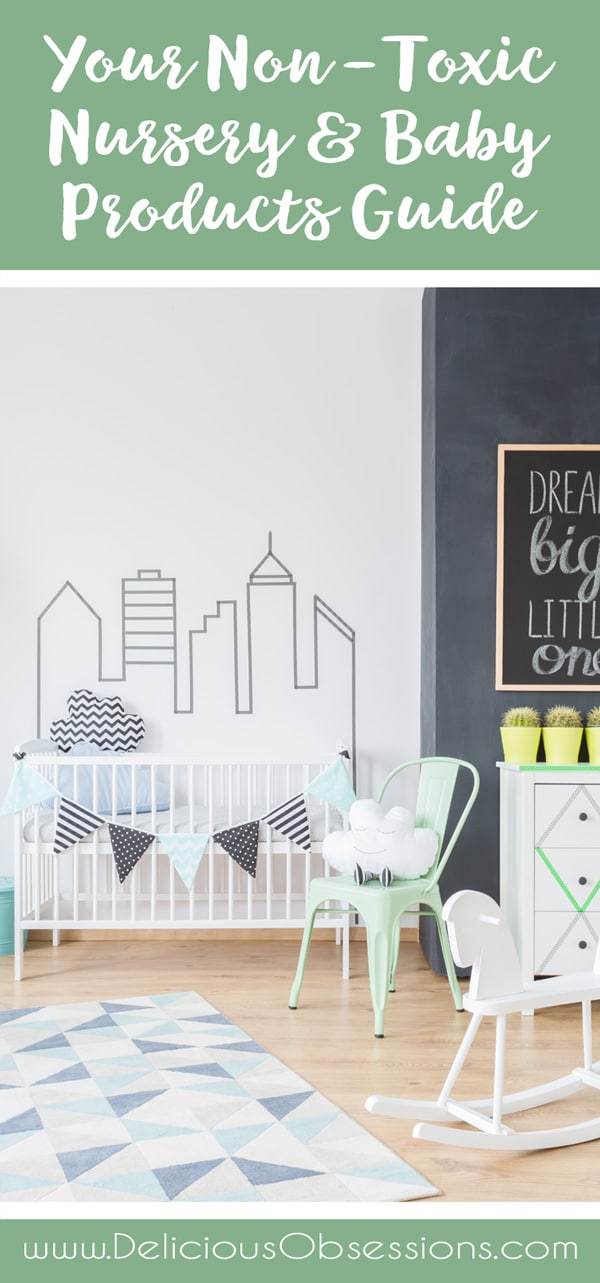
How To Chose What to Non-Toxic Products to Focus On
After I started feeling myself getting a wee bit stressed, I took a step back and asked myself a simple question:
“What items are going to be used all day, every day by the baby?”
These items are the things that are going to give us the biggest bang for our buck when it comes to investment. The more time the baby is exposed to an item, the more important it is to lessen the chemical load for them.
From there, I was really able to prioritize the items that I felt I needed to spend more on. And then I slowly learned to just let go of the rest. This list may vary from person to person, but for us, these were our top priorities:
- Crib + Mattress – Because babies are going to sleep all. the. time. So spending some extra money on safer products for their sleeping arrangements is money well spent in my opinion.
- Car Seat – Car seats can be some of the most toxic items out there. Where we currently live is pretty far from our family and our pediatrician, so baby is going to be spending a lot of time in a car seat as drive back and forth. Plus, he’s being born right before summer and the hot summer weather causes more off-gassing of the toxic car seat chemicals.
- Diapers + Diaper Wipes – This is the one item that is going to be on them 24/7 so it’s a great place to spend a little extra money for the non-toxic versions. We decided to cloth diaper the majority of the time (which I’ll be talking about below), but we are going to use disposables for the first couple of months (as we settle into new parent life) and then occasionally as needed the rest of the time.
- Skin and Body Care – No surprise here that I am concerned about what I put on baby boy’s skin. As a safe skincare consultant, this is an area I am super passionate about. You would be stunned at the chemicals used in baby products! Thankfully babies truly don’t need much in the way of skin care products so this is actually quite affordable, depending on what items you decide to use.
Other areas you might consider:
- Strollers – Like car seats, strollers can also be treated with toxic chemicals like fire retardants. If you’re super active and plan on baby hanging out in the stroller a lot, this might be an area to spend a little more money in.
- Carriers and Wraps – This was another area that might be worth considering more non-toxic versions since (depending on how active you are out and about), the baby might spend a lot of time in them.
- Clothing – This one may not be of importance, depending on the family. All babies need clothing and it’s something that’s on their skin all the time so there is definitely some concern over what they might be wearing. Believe it or not, for newborns, there are some pretty affordable organic options out there. I did end up with some organic options, but I also was fortunate to receive a TON of hand-me-downs from family friends so we ended up not needing to buy much in the way of clothing to get started.
And, depending on the family, there may be other items that you would add to this list, depending on your individual needs.
Your Non-Toxic Nursery and Baby Products Guide
Because I was researching pretty much everything under the sun, I decided to compile a guide for you, broken down into categories. Here’s what I’ll be covering:
- Non-Toxic Cribs
- Non-Toxic Crib Mattresses
- Non-Toxic Car Seats
- Non-Toxic Diapers
- Non-Toxic Diaper Wipes
- Non-Toxic Bath and Body Care
- Miscellaneous Baby Items
Under each section, I’ll talk about the most important things to be on the lookout for and then offer safer brand recommendations, based on my own research. I encourage you to research this stuff too and decide what is going to be the best fit for your family and budget.
Also, I want to mention that this is FAR from an exhaustive list. I didn’t research every option on the market, but hopefully, this is a good starting place for you to do your own research. Or, if you are already feeling stressed out about it and don’t want to research anymore, hopefully this guide will help give you some ideas of products that might work for your needs.
NON-TOXIC CRIBS
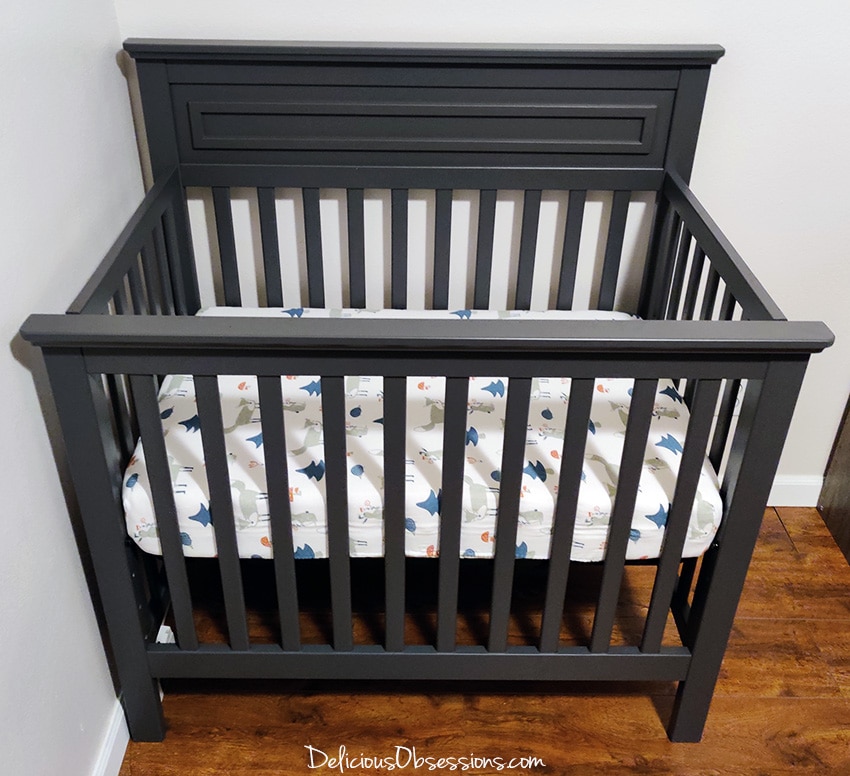
When it comes to cribs, the main concern is around the materials used to build it and the type of paint or stain used for finishing it. Cheaper cribs are often built with composite woods, which can off-gas volatile organic compounds (VOCs). According to the EPA, the concentration of VOCs is often 10 times (or more) higher inside the home than outside.
VOCs have been linked to:
- Eye and respiratory system irritation
- Headaches, dizziness, loss of coordination, and nausea
- Damage to the liver, kidneys, and central nervous system
- Cancer in animals (some are suspected or known to cause cancer in humans)
Cheap, composite wood (like MDF or plywood) often contains toxic glues, formaldehyde, and cheap veneers, all of which off-gas VOCs. In addition, the paint or stain used for finishing can also off-gas VOCs. Keep in mind that VOCs off-gas from more than just our paints and furniture. They come from anything that is made with high levels of chemicals (think common household cleaning products, aerosol sprays, air fresheners, hobby/craft supplies, pesticides/herbicides/fungicides, etc.). This is why it really is important to choose safer, low-and no-VOC products whenever possible.
When choosing a crib (or other furniture), think about:
- Solid wood construction, if at all possible.
- Raw wood or wood that has been treated with low- or no-VOC paint or stain. If you get something with raw wood, you can finish it yourself using safer products.
- Greenguard Gold Certification (GGC), which means the manufacturer has met very strict standards for the chemical composition of their products and indoor air quality testing. Greenguard Gold Certification means that the furniture is tested for 10,000+ chemicals and 360+ VOCs. Keep in mind this certification applies to more than just furniture, so look for it when researching other baby gear like mattresses, car seats, strollers, etc.
I spent a lot of time thinking about the crib situation. At first, we weren’t even going to buy one. And then we decided to go ahead and get one. And then we realized that a standard size crib was going to be too big for our small bedroom. Thankfully, we discovered mini cribs, which are perfect for what we need. Small, compact, and stylish. Plus many of them converts from a crib to a toddler bed to a twin bed so it’s really a one-time investment that will give us many years of use.
After a ton of research, we decided to go with the DaVinci brand because they are Greenguard Gold certified and very affordable. Plus they had a nice selection of mini cribs. Not all crib manufacturers make mini cribs, so once we decided to go the mini route, that really narrowed down what was available for us to choose from.
We got the DaVinci Autumn 4-in-1 Convertible Mini Crib (which you can see in the photo above) and absolutely love it. It has a lovely minimalistic design and was easy for hubby to put together. It also fits perfectly into the small space in our master bedroom where a lot of baby boy’s stuff will be residing.
Other Non-Toxic Crib Brands to Consider
- Babyletto Brand (wide variety of styles and prices)
- Ikea Sniglar Crib (solid wood construction)
- Oeuf Sparrow Crib (very high-end and expensive)
- Delta Children (affordable, not GGC, but the company has a high level of safety standards)
NON-TOXIC CRIB MATTRESSES AND SHEETS
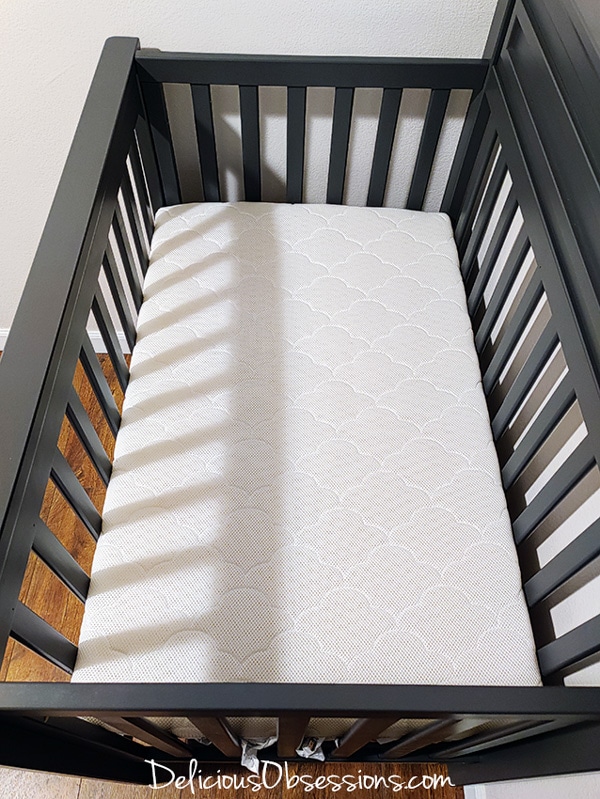
Like cribs (and car seats, which you’ll read about below), mattresses can also off-gas harmful VOCs (from the materials they are made of, typically petroleum-based foams, PVC, etc.). Since babies will spend most of their days sleeping, reducing their exposure to these chemicals is really important. According to studies done by the University of Texas at Austin:
…the team found that the mattresses release significant amounts of volatile organic compounds (VOCs), potentially harmful chemicals also found in household items such as cleaners and scented sprays. The researchers identified more than 30 VOCs in the mattresses, including phenol, neodecanoic acid, and linalool. The most abundant chemicals identified in the crib mattress foam, such as limonene (a chemical that gives products a lemon scent), are routinely found in many cleaning and consumer products.
In addition, crib mattresses (and ALL mattresses in general) contain chemical flame retardants, which are terrible for our health. I’ll discuss flame retardants in the next section about car seats.
Once we knew that we were going to go with a mini crib, the decision on what mattress we got pretty much got made for us. While there are quite a few safe mattresses for standard-sized cribs, there are very few non-toxic options out there for mini cribs. Thankfully, the brand that I had already wanted to go with offers a mini crib size, so it worked out great.
We chose the Newton Baby brand mattress for a couple of reasons:
- It’s 100% breathable
- It’s made from non-toxic materials
- It’s 100% washable (yes, I can wash the whole mattress in our shower or tub!)
- It’s Greenguard Gold Certified
- It met all my criteria AND was available in mini size 🙂
Other Non-Toxic Mattress Brands to Consider
- Lullaby Earth Breeze Breathable Crib Mattress
- Naturepedic Organic Baby Crib Mattress
- Moonlight Slumber Little Dreamer Crib Mattress
- Emily Natural Cotton/Wool Crib Mattress
On a side note, organic crib sheets are very affordable so if you want to add another layer of non-toxic protection, consider adding a set or two to your registry. Here are a few brands to consider:
- Pickle & Pumpkin Organic Crib Sheets Set (this is the set we got)
- Mosa Creations Organic Jersey Cotton Crib Sheets
- Natemia Organic Turkish Cotton Crib Sheets
- My Little North Star Super Soft Organic Jersey Cotton Crib Sheets
- Burt’s Bees Baby Organic Cotton Fitted Crib Sheets
NON-TOXIC CAR SEATS
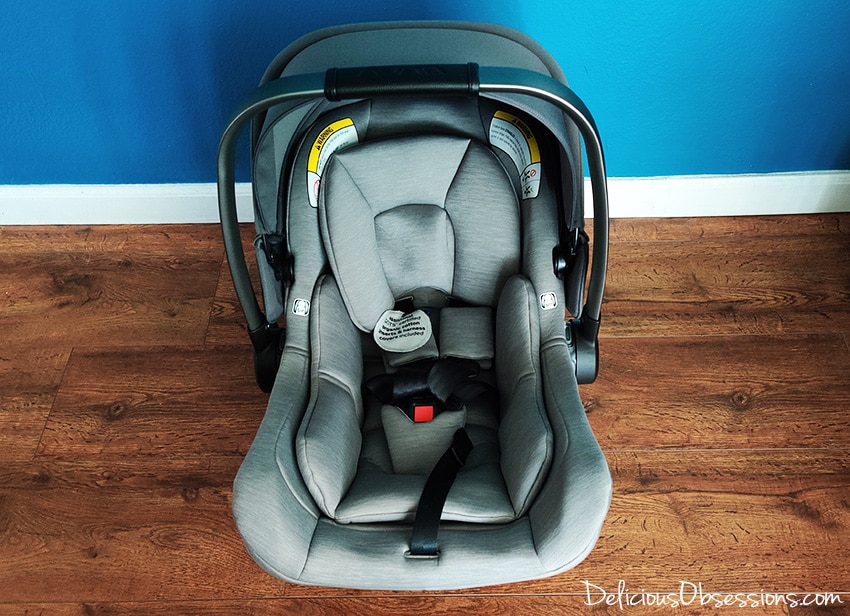
Boy, the car seat research about drove me insane. This was by far our most expensive purchase. But, I feel like it was a good investment, especially with how much time the baby will be spending in it. The main concerns with car seats are the heavy metals and flame retardant chemicals that are typically used.
The most commonly used chemicals in flame retardants are Brominated, Chlorinated, and Phosphate-based chemicals. Brominated and chlorinated-based chemicals (also called halogenated chemicals) are quite toxic and can lead to a number of long-term health issues, including:
- Cancer
- Reproductive Issues
- Developmental and Neurological Issues
- Hormonal Disruption
- Immune System Disruption
Phosphate-based chemicals are halogen-free and are a much safer choice for flame retardant capabilities if the car seat you want has that option. In addition, wool is also naturally flame retardent and a few brands have started using wool and other fabric blends instead of chemicals altogether. When choosing a car seat, consider companies that use wool or phosphate-based chemicals, if possible. For a full list of the chemicals of concern, check out this article from the Ecology Center.
We ended up going with the Nuna Pipa Light car seat. I chose this car seat for a few reasons:
- It doesn’t contain any chemical fire retardants (they use a special knit fabric and foam that are naturally fire-resistant).
- It is Greenguard Gold Certified.
- It’s super light (just in case either grandma needs to tote him around at any point).
- It exceeds American safety standards and has a load-bearing leg that extends to the floor of the car, which helps improve overall safety.
- It’s really easy to install.
I am super pleased with this car seat and feel it was worth the financial investment. Finally making a decision on which car seat to get was like a huge weight off my shoulders.
Other Non-Toxic Car Seat Brands to Consider
- Uppa Baby Mesa Infant Car Seat (in the colors Henry and Jordan – they use OEKO-TEX Standard 100 certified wool, which is naturally fire-retardant)
- Clek Liing Infant Car Seat (in the color Mammoth – they use OEKO-TEX Standard 100 certified wool, which is naturally fire-retardant)
- Britax Advocate ClickTight SafeWash Convertable Car Seat (in the color Otto – they use their “SafeWash” knit cover that is naturally fire-retardant)
- Britax Marathon Clicktight Convertible Car Seat (this one is not completely fire retardant free, as they use halogen-free phosphate-based fire retardant chemicals instead of the toxic brominated and chlorinated based chemicals, but this is still a way better option than others)
- Clek Fllo Convertible Car Seat (in the color Mammoth – they use wool, which is naturally fire-retardant)
NON-TOXIC DIAPERS
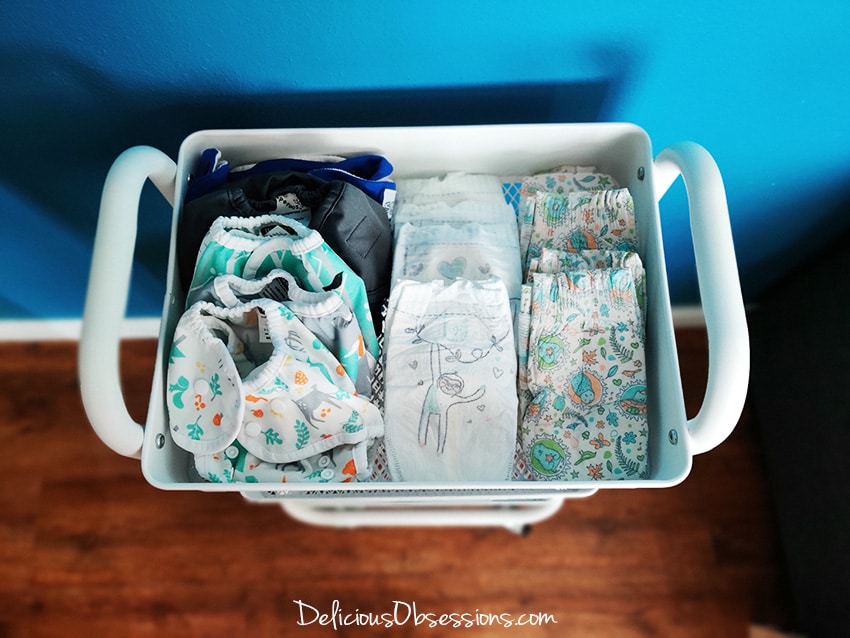
If there’s one thing that baby is going to be exposed to all day, every day, it’s diapers. As with everything already discussed in this post, the toxicity of diapers comes down to the materials used in creating them. The main areas of concern with disposable diapers are:
- Chlorine and its Derivatives (also called Dioxins) – The Environmental Protection Agency (EPA) has identified dioxins as a “likely human carcinogen“. According to the World Health Organization (WHO), they belong to the “dirty dozen”, which is “a group of dangerous chemicals known as persistent organic pollutants (POPs)”. Animal studies of dioxin exposure have shown that there is strong potential for this chemical to cause developmental and reproductive issues, as well as damage to the immune system, disruption of the endocrine/hormonal system, and cancer. (source 1, source 2, source 3)
- Volatile Organic Compounds (VOCs) – We discussed VOCs and their health implications in the above sections but the ones that are most commonly found in disposable diapers are methylene chloride, toluene, and xylene. (source 1, source 2)
- Tributyltin (TBT) – TBT compounds have been found to be highly toxic with strong negative effects on human and environmental health. It has been extensively studied in regards to its contamination to marine life which has caused irreversible damage to those ecosystems. In addition, TBT has also been linked to obesity in humans because it can trigger genes that cause the growth of fat cells in the body. (source 1, source 2)
- Phthalates (dyes, glues, and “fragrance”) – You’ve probably heard me mention phthalates before in regards to our makeup and skincare, but these toxic chemicals are also present in disposable diapers. Thanks to a legal loophole, any time a company uses the word “fragrance”, they are not required to disclose the specific chemicals present. Phthalates are known to cause reproductive and developmental harm, as well as allergic reactions. One PubMed review found that “diapers contain higher phthalate contents than those in common commercial plastic products“. (source 1, source 2, source 3)
Hubby and I are going to be mainly using cloth diapers for our baby (which automatically eliminates a lot of these exposures), however, we are going to need to use disposables from time to time. We are planning on using disposables for the first 6-8 weeks as we settle into new parent life. So, I still need to have safer, less toxic options for those times. I’ll do a separate blog post on cloth diapering since that is a big enough topic all on its own.
When it comes to non-toxic disposable diapers, there are actually a number of options on the market. Our plan is to test out a bunch of different brands and see what works best for our baby. These are the brands we are going to test first (based on reviews from other moms and dads):
- Honest Company – Plant-based materials with no latex, chlorine processing, fragrances, or lotions.
- Seventh Generation – Their diapers are chlorine-free, with no fragrances. Any ink/dye they use is made without the use of lead and other heavy metals
- Thrive Market – These are some of the most affordable non-toxic diapers out there and well worth the membership cost if you don’t already have a membership. They get great reviews from parents! If you don’t already have a membership, you can get up to $20 in shopping credit when you join via this link. You can also learn more about why I love Thrive Market in this post.
- Andy Pandy – I’ve been told that this is the best non-toxic diaper for extra-sensitive babies. Free of chlorine, alcohol, preservatives, phthalates, latex, PVC, and TBT.
- Pampers Pure – I love that a mainstream diaper manufacturer is listening to consumer demand and producing a safer version of their product. Free of chlorine processing, parabens, phthalates, and latex. These will be easy for our local family to get, should grandma ever need to grab a package for babysitting. 🙂
- Dyper – They are a pretty cool subscription service that sends you the exact quantity of diapers you need each month, based on your child’s age. If you need more, they send them ASAP. If you have leftovers, you simply return them with a prepaid label. No chlorine, latex, alcohol, perfumes, PVC, lotions, TBT, inks/dyes, or phthalates.
Other Non-Toxic Disposable Diaper Brands to Consider
When it comes to diapers, not every diaper is going to fit every baby well. Some parents might love one brand, while other parents will hate that same brand. Here are a few other options to consider if none of the above work well for your needs.
NON-TOXIC BABY WIPES
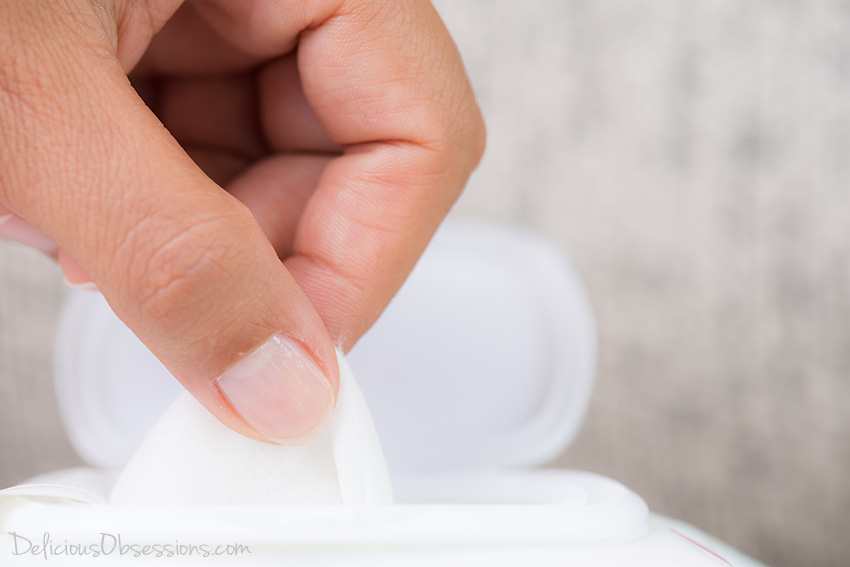
With diapers, come wipes. You would think that something as basic as a baby wipe would be pretty simple and chemical free, right? Wrong. Wipes can be so full of toxic ingredients that it’s honestly a little mind-boggling. Here are the top ingredients you should avoid when choosing safer wipes. If you would like to research each individual ingredient more, I highly suggest using the Environmental Working Group’s (EWG) Skin Deep Database.
- Polysorbate-20 – Commonly used as a preservative and is often contaminated with 1,4-dioxane and ethylene oxide, both of which have strong carcinogenic links, as well as developmental and reproductive toxicity issues. (source and more info)
- Phthalates (i.e. Fragrance) – We discussed phthalates and fragrance in the diapers section. Phthalates are known endocrine system disruptors and thanks to a legal loophole, the specific chemicals do not have to be disclosed by manufacturers. Look for: “fragrance”, “parfum”, “parfume”, or anything that indicates scent of any sort. I’ll be addressing essential oils below. (source and more info)
- Parabens – Parabens are a type of synthetic preservative that are typically used to stop the growth of bacteria and fungus in personal care products. They are easily absorbed through the skin and are known to mimic the hormone estrogen, while also disrupting overall hormone function. They are also linked to cancer and fertility issues. Look for anything that ends in “paraben”, like ethylparaben, methylparaben, butylparaben, propylparaben, and isobutylparaben. (source and more info)
- Phenoxyethanol – Another preservative that has been suspected of causing irritation to the eyes, skin, and lungs. There is also some concern about immunotoxicity with this ingredient, although safety data is limited at this time. It’s still an ingredient of concern that should be avoided if possible. (source and more info)
- Formaldehyde and formaldehyde-releasing agents – Most of us are familiar with formaldehyde from high school biology classes. This ingredient, and releasing agents, are well known to cause cancer, as well as damage to the reproductive system and central nervous system. It’s commonly used in personal care products as a preservative and it’s absorbed via inhalation or the skin. Most ingredient labels are not going to list it as an ingredient, so you need to look for formaldehyde-releasing chemicals like: DMDM hydantoin, Imidazolidinyl urea, Diazolidinyl urea, Quaternium-15, Bronopol (2-bromo-2-nitropropane-1,3-diol), 5-Bromo-5-nitro-1,3-dioxane, and Hydroxymethylglycinate. (source and more info)
- Petroleum-based ingredients like propylene glycol (PG) or polyethylene glycol (PEGs) – These ingredients are used as a “penetration enhancer”, meaning they help the product soak into your skin faster and easier. Depending on how these ingredients are manufactured, they can be contaminated with large amounts of ethylene oxide and 1,4-dioxane, both of which have strong carcinogenic links, as well as developmental and reproductive toxicity issues. (source and more info)
- Sodium Laurel/Laureth Sulfate (SLS/SLES) – SLS and SLES are used as surfactants or detergents in cleaning products, including baby wipes. These ingredients have been linked to endocrine system disruption, fertility issues, neurotoxicity, organ toxicity, skin allergies, and possibly cancer. (source and more info)
- Methylisothiazolinone (MIT) – Another preservative that used to really extend the shelf-life of a product. For the most part, companies have phased out this ingredient, but you may still find it from time to time, so read your labels. A study in 2012 found that “brief exposure to MIT is toxic in low concentrations during neural development, increasing the risk of seizures and visual abnormalities“. Another study on rat brain cells found that MIT caused damage to those cells with an exposure time that was only 10 minutes long. In addition to these issues, it is a well-known allergen that causes contact dermatitis. (source and more info)
- Iodopropynyl butylcarbamate (IPBC) – Yet another preservative, IPBC gets absorbed by the skin and can cause immune system problems, as well as contact dermatitis. It is also highly toxic via inhalation. The EU restricts its use because IPBC may contribute to unsafe levels of iodine in the body. It’s not to be used in products where high concentrations or ingestion can take place (i.e. lotions, soaps, lip products, etc.). (source 1, source 2)
- Essential Oils – You might be wondering why I’ve included something natural like essential oils on this concerning list. The primary reason for this is that babies are sensitive and essential oils are powerful. If you know much about EOs, you know that there are specific ones that you simply do not use on, or around babies and children. You also know that there are proper dilution methods required for the ones you use. In addition, EOs are notorious for being contaminated with other things, so purity is of great concern. It’s just best to steer clear of baby products containing them unless you know for sure the type of EO, purity, and dilution levels.
Whew! Can you believe there is so much junk in a product we use on our delicate little babies? No wonder our children’s toxicity levels are going through the roof!
Thankfully there are some really great, non-toxic products on the market to choose from. Since hubby and I are going to cloth diaper, we are also planning on using cloth wipes. It just makes sense and cuts down on chemical exposure and waste. That said, we will keep some disposable wipes on hand for family and friends who may not be all that keen on the whole cloth thing. 🙂
The brand that we plan on using is Water Wipes. This brand has come highly recommended and affordable. Water Wipes actually only contain two ingredients: water and fruit extract, so we literally don’t have to worry about any other chemical exposure. Another brand that we may try based on a friend’s recommendation is Bloom Baby Wipes. These wipes contain more ingredients (but nothing toxic), but they are supposed to be a lot thicker and more durable than most other brands. So we’ll give them a go as well.
Other Non-Toxic Baby Wipe Brands to Consider
You know, when I first started researching wipes, I came across long lists of “best non-toxic wipes”. But once I started looking at the individual ingredients, I really couldn’t find that many that met my requirements. Even the cleanest wipes can still contain some questionable ingredients like PEGs and high levels of essential oils. So I encourage you to do your own research and see what you feel comfortable with. These are two that I would feel comfortable using:
NON-TOXIC BATH AND BODY CARE
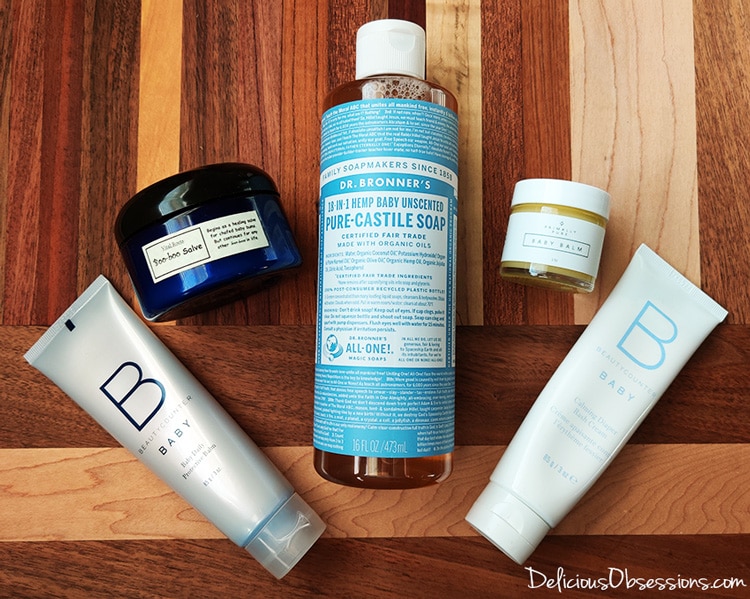
Since I am so passionate about education around safer personal care products, I’m sure you’re not surprised that I also put some focus into what I would be using on baby boy. Honestly, this was probably the easiest section of my long research list to tackle because I already know so much about safer skincare products and have my own favorite brands.
When it comes to skin and body care for babies, let’s remember that babies don’t need much. There are lots of fancy, schmancy products out there for baby, but truly you don’t need fancy stuff. If you just want to use castile soap and coconut oil (and that works for your baby’s skin), then do it!
When it comes to selecting the best bath and body care products for your baby, everything we talked about in the diaper and wipe section applies. So pay attention to ingredients like phthalates (i.e. “fragrances”), parabens, formaldehyde (and formaldehyde-producing ingredients), sodium laurel/laureth sulfate, petroleum-based oils, essential oils, etc.
In addition, I’d encourage you to check out Beautycounter’s Never List, which is a comprehensive list of commonly used skin and body care ingredients that are toxic and harmful to our health. It is far more comprehensive than I could ever write here and there’s a printable version that you can take with you to the store. Also, consider using the Environmental Working Group’s (EWG) Skin Deep Database to also vet questionable ingredients.
Beautycounter really is my top go-to for safe skincare products and these are the things that I personally will be using on baby boy when he arrives:
- Baby Gentle All-Over Wash – A very gentle, tear-free soap that is fragrance-free. I’ve heard moms who have babies with super sensitive skin say that this is the only soap that doesn’t irritate them.
- Baby Calming Diaper Rash Cream – This EWG-certified cream is zinc-based and mamas say that it works better than most other rash creams they’ve tried.
- Baby Daily Protective Balm – I actually use this on my hands overnight during the winter when my skin gets so cracked and dry. It will be super helpful if baby boy ends up with dry or irritated patches on his skin.
- Baby Soothing Oil – I’ve also used this oil on my skin during the winter months when my skin gets super dry and flaky. It will be great for a lightweight moisturizer for baby boy when he needs it.
In addition to Beautycounter, some of my other favorite non-toxic skincare brands are:
- Primally Pure Skincare – They have some wonderful safe baby products, including their popular Baby Balm, Baby Oil, and Baby Powder.
- SAVINGS ALERT: Use coupon code DELICIOUS10 and save 10% on your first order from Primally Pure!
- Vital Roots Herbal Care – This company is run by one of my BFFs, Lori Roop, a clinical herbalist and nutritionist. She handcrafts all of her products from very precise herbal formulas and her products are AMAZING. I actually use some of her baby products on my own skin (and have for many years), like the Happy Baby Salve (I used this as a stretch mark salve during my pregnancy!), Herbal Luscious Baby Oil, and Natural Baby Spray.
- SAVINGS ALERT: Use coupon code DELICIOUS10 and save 10% on your first order from Vital Roots Herbal Care!
- Earth Mama Organics – This company offers a wide range of products for both mama and baby. Their postpartum products were HIGHLY recommended to me but in addition to those, a few of the items that I’ve been told I should definitely try out with baby boy: Calendula Baby Oil, Non-Scents Calendula Baby Lotion, and Organic Diaper Balm
- Dr. Bronner’s – Known for their pure Castille soaps, I will be keeping a bottle of their Unscented Baby Soap on hand.
Honestly, when it comes to picking out skin and body care products for your baby (or yourself), it’s going to come down to experimentation. Some brands are going to work great, while others won’t. So what works great for me, might not work so great for you.
OTHER MISCELLANEOUS ITEMS WE PURCHASED
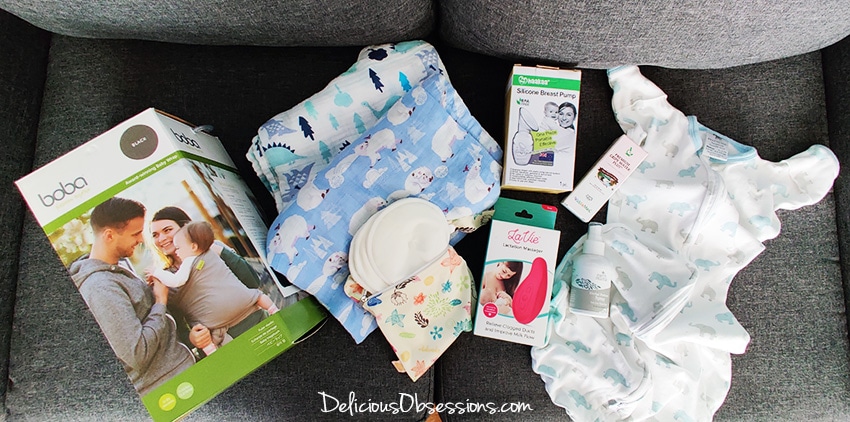
In addition to the bigger items above, there are a handful of other things we purchased that I thought I’d share with you too. We really tried to be mindful of what we purchased because of budgetary and space issues. Babies truly don’t need much, despite what all of the clever marketing tells you.
I also spent a lot of time talking to other mamas and really finding out what products they love and can’t live without. The things that got recommendations over and over and over again are really the only items we considered buying. We figure we can always fill in the gaps as needed once baby boy is here.
Swaddles
I really wanted some super soft organic cotton muslin swaddle blankets since baby boy will be spending so much time in them. We actually ended up with quite a few hand-me-downs and a couple of packs of swaddles at our baby shower so we didn’t have to purchase any. The ones we were gifted are these Aden + Anais Muslin Swaddle Blankets (this brand was one of the most highly recommended baby brands to me by other mamas) and these HAOK Muslin Swaddle Blankets.
Thankfully there are some really beautiful and affordable brands available on Amazon (even for organic!). Had we not been gifted so many swaddles, these are the ones I was looking at purchasing:
- Cotton Organics Muslin Swaddle Blankets
- Green-Wood Organic Cotton Muslin Swaddle Blankets
- ArugumBaby Organic Cotton Muslin Swaddle Baby Blankets
- Burt’s Bees Baby Organic Cotton Muslin Swaddle Blankets
Swaddle Sleep Sacks
In addition to swaddle blankets, I was told to test out swaddle and sleep sacks with baby. Some babies HATE being swaddled with traditional swaddling blankets, but love swaddle sleep sacks. Because I know sleep is going to be a precious commodity, I was willing to invest some extra in having a few on hand, just in case. I got a couple of brand-new ones and then lucked out and found a couple at a local consignment store.
- Amazing Baby Swaddle Sack with Arms Up
- Cambria Baby Adjustable Infant Swaddle Wrap
- Burt’s Bees Baby Wearable Blanket
- Love To Dream Swaddle UP
- Halo SleepSack Swaddle
Baby Wrap and Structured Carrier
Hubby and I both plan on babywearing, so after much research, we decided to get one of each. He was much more interested in the structured carriers like LÍLLÉbaby, while I feel like I will prefer the wrap-style instead. These are the ones we got:
- Boba Wrap Baby Carrier
- LÍLLÉbaby Complete All Seasons Baby Carrier – What we really love about this carrier over so many other structured carriers is the extra back support it offers. Plus the straps are super padded to prevent fatigue and stress on the back.
There are SO many wrap and carrier options out there. I did a ton of research and finally settled on these two based on the feedback I had gotten from other moms and the functionality of each brand. Depending on where you live, there might be local wrap/carrier sharing groups where you can meet other parents and try out different brands in person before you buy. Sometimes they even have lending libraries where you can check out a carrier for a short amount of time.
Diaper Bag Backpack
Dang! When it comes to diaper bags, there are A LOT to choose from. I honestly had no idea what to go for, but then a HUGE discussion happened in one of my mama groups and this Lifewit Diaper Bag Backpack came so highly recommended that I didn’t even research any other ones! Everyone who has it loves it.
LaVie Lactation Massager
This lactation massager was a total splurge product for me that I was skeptical about. But I have heard so many moms say that it has saved them when manual massage just wouldn’t get rid of clogged ducts. One of my biggest fears is mastitis (thanks to some horrific pictures I saw a few years ago that scarred me for life), so I’m willing to do whatever I can to try to avoid it.
Breastfeeding & Therapy Pads
Another item that mamas said they can’t live without is breastfeeding pads. Both the ones to contain leaks, but also reusable ones that can be used for hot and cold therapy. The ones I ended up with are:
- Ameda ComfortGel Soothing Breastfeeding Pads and Lansinoh Therapearl 3-IN-1 Breast Therapy Pads – These are both reusable pads that can be used for hot/cold therapy on my breasts. In addition, my doula said they can be really helpful for baby too. You can warm them up and hold them on their belly if they’re experiencing stomach pain.
- Kindred Bravely Organic Washable Breast Pads – I figured since I’m already doing cloth diapers, why not cloth breast pads? But, several mamas said they reusable ones never worked well for them, so I did get a few disposable brands to test out.
- Medela Safe & Dry Ultra Thin Nursing Pads and Bamboobies Disposable Nursing Pads and Lansinoh Stay Dry Disposable Nursing Pads – I got the smallest containers possible of each of these to test out. These were the three brands that most mamas recommended. Like everything else, I was told that you may have to try a couple of different brands to find ones that work best for you.
Breast Pumps
I really struggled with the whole breast pump thing. Since I don’t have traditional health insurance, getting the free one that is offered under the Affordable Healthcare Act was not an option. So I was going to have to pay out of pocket for an electric pump. I did a ton of research on electric pumps. And I polled a ton of mamas. And I watched a ton of YouTube videos. I finally decided to skip the electric pump for now and just go with a manual pump and a Haaka to collect letdown while I’m nursing. If I end up needing an electric pump, I can purchase one at a later date or rent one locally.
- Haakaa Manual Breast Pump – Almost every mama I spoke to said this is a MUST-HAVE for breastfeeding moms. A lot of them said they were able to build up a nice freezer stash of milk just from what they caught in this during the letdown.
- Medela Harmony Manual Breast Pump – So many moms told me that they got electric pumps only to never use them, but that they LOVED this manual pump. Even my OB agreed that this was a great choice.
Other Baby and Mama Personal Care Items
There were a handful of other things that mamas said I needed. Here are the other items that I ended up getting to have on hand once baby boy gets here.
- ChildLife Organic Gripe Water– Apparently a must-have for all baby belly discomfort
- FridaBaby Baby Basics Care Kit – I can’t believe how many moms told me that the Windi and the NoseFrida are total lifesavers.
- Earth Mama Herbal Perineal Spray – I’m going to be making a few padsicles, but a lot of mamas told me they much preferred this spray instead of padsicles. So I’m going to try both and see which I like better.
- Earth Mama Nipple Butter Breastfeeding Cream – Another Earth Mama product that was highly recommended!
- WishGarden Herbs AfterEase Organic Herbal Supplement – I love WishGarden Herbs and use a lot of their products already. This specific tincture is supposed to help with afterbirth pains as your uterus shrinks and heals.
- Legendairy Milk® Sunflower Lecithin – As I mentioned above, mastitis is one of my great fears. My ND and a bunch of other moms said that sunflower lecithin was a total game-changer for them when it came to clogged ducts. This brand was always the top one mentioned.
What Say You?
Well, I hope this guide has been helpful! I figured if I was doing all of this research for myself, I might as well share. I am fully aware that once baby is here and we start getting to know him, there may be other things we need to buy. And there might be stuff on this list that we never even use. Only time will tell, but it’s been a fun journey!
I’d love to hear from you in the comments below. What items would you add to this list? What things were absolute MUST-HAVES for your new baby? Leave me a comment below! 🙂

